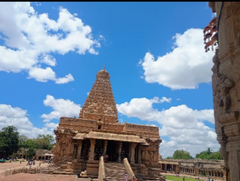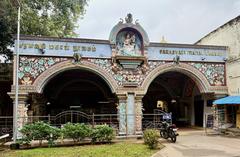Visiting Aiyarappar Temple: History, Tickets, and Tips
Date: 16/08/2024
Introduction
The Aiyarappar Temple, also known as Panchanadeeswarar Temple, is a revered site dedicated to Lord Shiva, located in the town of Thiruvaiyaru, Tamil Nadu. This temple is not only a hub of religious activity but also a marvel of historical and architectural significance. The Aiyarappar Temple’s origins are deeply rooted in the Chola dynasty, with substantial contributions from the Pandyas and the Vijayanagara emperors, making it a significant monument in South Indian history (Wikipedia). This comprehensive guide will delve into the temple’s history, cultural significance, and the various aspects that make it a must-visit destination for devotees and history enthusiasts alike. From the architectural wonders that define its structure to the rich inscriptions that tell tales of its past, the Aiyarappar Temple stands as a testament to the architectural and cultural prowess of ancient India (This Day).
Table of Contents
- Introduction
- History of Aiyarappar Temple
- Architectural Evolution
- Inscriptions and Historical Records
- Visitor Information
- Special Events and Festivals
- Nearby Attractions
- Preservation and Management
- FAQ
- Conclusion
Everything You Need to Know About Visiting Aiyarappar Temple: History, Tickets, and More
Introduction
The Aiyarappar Temple, located in Tiruvaiyaru, Thanjavur, Tamil Nadu, is a significant historical and religious site dedicated to Lord Shiva. This article provides a comprehensive guide to the temple’s history, architecture, visitor information, and more.
History of Aiyarappar Temple
Origins and Early History
The Aiyarappar Temple’s origins are deeply rooted in the Chola dynasty, with substantial contributions from the Pandyas and the Vijayanagara emperors. The temple is divided into two main sections: Uttarakailasam and Dakshinakailasam. Uttarakailasam was established in the late 10th century by the queen of Rajaraja Cholan, who made significant contributions to its construction and development. Later, Dakshinakailasam was renovated by the queen of Rajendra Cholan, further enhancing the temple’s grandeur (This Day).
Chola Dynasty Contributions
The Chola dynasty, known for its patronage of art and architecture, played a pivotal role in the development of the Aiyarappar Temple. Various inscriptions within the temple confirm its historical ties to the Chola rulers. Notably, an inscription on the south wall, dated to the 21st regnal year of Rajaraja I, documents land transactions, indicating the temple’s economic significance during that period. Another inscription from the king’s 24th year details precious jewels offered to the deities, showcasing the wealth and devotion of the Chola rulers (This Day).
Rajendra Chola I and Rajadhiraja I
Rajendra Chola I, the son of Rajaraja Chola, continued his father’s legacy by making significant contributions to the temple. An inscription from Rajendra I’s fourth regnal year records land grants, further emphasizing the temple’s importance as a religious and economic center. Additionally, a significant inscription from Rajadhiraja I’s thirty-second year recounts the king’s victories over three Pandya monarchs, highlighting the temple’s role in commemorating the Chola dynasty’s military achievements (This Day).
Vijayanagara Period
The Vijayanagara emperors also played a crucial role in the temple’s history. They made significant contributions to the temple’s architecture and maintenance, ensuring its continued prominence as a religious and cultural center. The temple’s architectural style reflects the influence of the Vijayanagara period, with intricate carvings and sculptures that narrate stories from Hindu mythology (This Day).
Architectural Evolution
The Aiyarappar Temple is renowned for its intricate architecture, adorned with detailed carvings and sculptures narrating stories from Hindu mythology. Encompassing an area of approximately 60,000 square meters, it stands as one of Tamil Nadu’s largest temples. The temple complex includes five prakarams (enclosures), four gopurams (gateway towers), and numerous mandapams (halls). The masonry work, including the soaring gopuram gateways, is a blend of Chola dynasty foundations and later enhancements up to the Thanjavur Nayaks in the sixteenth century (This Day).
The Gopurams and Mandapams
The temple, facing east, welcomes visitors with a seven-tiered pyramidal raja gopuram. The sanctum sanctorum houses the lingam-form deity, while the adjoining ardhamandapa mirrors its width and is twice its length. The Mukhamandapa is equally square. The sanctum’s exterior is adorned with five devakoshtas, with the only remaining images being those of Dakshinamurthy and Brahma. Two colossal Dvarapala guardian deities stand sentinel on either side of the ardhamandapa entrance (This Day).
Inscriptions and Historical Records
The temple’s rich history is further evidenced by numerous inscriptions found within its premises. These inscriptions provide valuable insights into the temple’s historical significance, economic transactions, and the contributions of various rulers. For instance, an inscription on the south wall, dated to the 21st regnal year of Rajaraja I, documents land transactions, indicating the temple’s economic significance during that period. Another inscription from the king’s 24th year details precious jewels offered to the deities, showcasing the wealth and devotion of the Chola rulers (This Day).
Visitor Information
Visiting Hours
The Aiyarappar Temple is open to visitors from 6:00 AM to 12:00 PM and from 4:00 PM to 8:00 PM daily. It’s advisable to visit during early morning or late evening to avoid the heat and crowds.
Tickets and Entry Fees
There is no entry fee for visiting the Aiyarappar Temple. However, donations are appreciated to help maintain the temple.
Accessibility and Travel Tips
The temple is accessible by road from Thanjavur, which is well-connected by train and bus services. For those driving, ample parking is available near the temple premises. Ensure to wear comfortable footwear as the temple complex is extensive.
Special Events and Festivals
The Saptha Stanam Festival
The annual Saptha Stanam festival, featuring seven Shiva temples in the region, draws considerable attention. Celebrated in April, this festival commemorates the wedding of Nandikeswara, Shiva’s celestial bull. According to belief, Nandi was born at this temple and became Shiva’s mount. The sacred union of Nandi and Suyasayambikai is celebrated during this festival. The festival deity of Thiruvaiyaru’s Aiyarappar temple, along with Nandikeswara and Suyasayambikai, is paraded in a decorated glass palanquin to temples in Thirupazhanam, Thiruchottruthurai, Thiruvedhikudi, Thirukandiyur, and Thirupoonthurthi. The journey concludes at the Aiyarappar shrine in Thiruvaiyyaru, where the seven palanquins converge. The Poochorithal (flower festival) involves devotees offering flowers to the primary deities in palanquins (This Day).
Nearby Attractions
Tiruvaiyaru is not only home to the Aiyarappar Temple but also several other historical sites. Visitors can explore the nearby Brihadeeswarar Temple in Thanjavur, a UNESCO World Heritage site, and the Saraswathi Mahal Library, known for its rare manuscripts.
Preservation and Management
Today, the Hindu Religious and Charitable Endowments Department of the Government of Tamil Nadu is entrusted with the preservation and management of this revered abode of Lord Shiva. The department ensures that the temple’s rich history and architectural grandeur are maintained for future generations to appreciate and enjoy (This Day).
FAQ
Q: What are the visiting hours for the Aiyarappar Temple?
A: The temple is open from 6:00 AM to 12:00 PM and from 4:00 PM to 8:00 PM daily.
Q: Is there an entry fee for the Aiyarappar Temple?
A: No, there is no entry fee, but donations are appreciated.
Q: What is the best time to visit the temple?
A: Early morning or late evening is ideal to avoid heat and crowds.
Q: Are there any special events at the temple?
A: Yes, the annual Saptha Stanam festival in April is a significant event.
Conclusion
The Aiyarappar Temple stands as an awe-inspiring showcase of Dravidian architecture, steeped in history and legend. Beyond Lord Aiyarappar’s sanctum, the complex boasts several other shrines. With its captivating carvings, architectural mastery, and sacred ambiance, it offers a profound spiritual experience. The temple’s rich history, intertwined with the Cholas, Pandyas, and Vijayanagara emperors, makes it a significant pilgrimage destination and a testament to the enduring power of faith and tradition (This Day).
Call to Action
Don’t forget to visit the Aiyarappar Temple during your trip to Tamil Nadu. For more information on other historical sites in Tiruvaiyaru, download our mobile app Audiala, and follow us on social media for updates.


